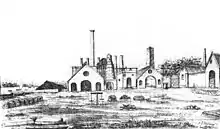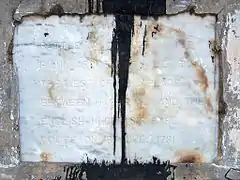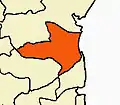Parangipettai
Parangipettai, historically called Porto Novo ("New Port" in Portuguese) is a panchayat town in Cuddalore district in the Indian state of Tamil Nadu. Parangipettai is located on the north bank of the mouth of the Vellar river at a distance of 30 km from Cuddalore. From the state capital city of Chennai, Parangipettai can be reached through the National Highway NH45A stretch between Cuddalore and Chidambaram.
Parangipettai
பரங்கிப்பேட்டை Porto Novo | |
|---|---|
Town | |
| Nickname(s): Muhamedbandar | |
 Parangipettai | |
| Coordinates: 11.49°N 79.76°E | |
| Country | India |
| State | Tamil Nadu |
| District | Cuddalore |
| Sub-district | Chidambaram |
| Population (2017)[1] | |
| • Total | 27,652 |
| Time zone | UTC+5:30 (IST) |
| PIN | 608502 |
| Telephone code | 04144 |
Due to its strategic location on the Coromandel Coast, Parangipettai has long been a major trading centre. In particular, it was an important trading destination for the Arabs, especially the Yemenis. During the colonial era the Portuguese, Dutch and then the English successively colonized the area.
The first iron and steel industry in India was constructed in Porto Novo in the year 1830.[2] Even today the iron pillars at the Egmore railway station in Chennai, Tamil Nadu have the imprint ' Made in Porto Novo'.
There is also a Gandhian connection to this place. Anne Marie Petersen became in 1909 a missionary in the so-called Loventhal Mission. The foundation stone was laid by Gandhi himself in 1921, and a few years later the school was officially opened under the name Seva Mandir at a place called Porto Novo, near Chidambaram in Tamil Nadu, South India.
Today, Parangipettai has evolved into a well-developed town with nearly all basic necessities such as healthcare, education and transport. It also hosts a Marine Biology Station affiliated with the Annamalai University.
Parangipettai is an important pilgrimage centre for both Muslims and Hindu.
History


Through history, Parangipettai has taken many different names. During the Portuguese rule it was - 'Porto Novo'. During the period of the Nayyakar rule it was renamed Muthukrishna Puri and then 'Mohammed Banthar' during the era of the Mughal Empire. In Tamil, Parangiar refers to Europeans, while Pettai means place. Thus, Parangipettai literally translates to the abode of the parangiars or Europeans in Tamil. Parangipettai finds mention in Classic Tamil literature as "Varunapuri", meaning the place where the rain god Varuna had worshipped Lord Shiva (still today this is a place known for its rainfall). The Portuguese were the ones who actually named this place "Porto Novo" ("New Port" in Portuguese) as they set up a port here and made it their trading stronghold.
Muslims living in Parangipettai have a unique ancestry. Tamil is their mother tongue but it has been heavily influenced by Urdu and Arabic. Previously, especially during the Tamil Chola rule of Tamil Nadu, Arab traders used to heavily trade around the Coromandel coast in which Parangipettai is located. Some traders, throughout time decided to settle down here. And hence, Muslims of Parangipettai tend to resemble Arab features. During the Muslim rule of India under the Mughal Empire, Muslims from Hyderabad began settling in Parangipettai. Thus the Islamic culture in Parangipettai was influenced by Urdu and Mughal practices.
In 1733, the Swedish East India Company established a factory in Porto Novo though after a month it was destroyed by the British and the French.[3]
A large trace of the Hyderabad people are found in Singapore and Malaysia. In 1801 Sir George Leith, who was then Lieutenant Governor of Penang,Malaysia, appointed a prominent Indian Muslim leader, Cauder Mohudeen, as Captain of the South Indian "Keling" community. He granted a piece of land to build a mosque on the south side of Malabar Street (Chulia Street).at penang now the mosque known as yusof kapittan mosque(monument of Malaysia) Cauder Mohudeen (born c. 1759) was a ship mandoor or foreman from Porto Novo, which the Tamils called Parangipettai.
The Battle of Porto Novo was fought here in 1781 during the Second Anglo-Mysore War. The conflict pitted the forces of the Kingdom of Mysore under Karim Khan Sahib, accompanied by his father Hyder Ali, against forces belonging to the British East India Company under Sir Eyre Coote. Though they were outnumbered 5 to 1, the British prevailed.
The town flourished as a sea port with connections to southeast Asia and as an industrial centre during British rule, when iron made here was exported to England. The powerful Nawab of Arcot had his mint at Porto Novo and the gold coins struck in this mint came to be called the Porto Novo Pagoda. Later the English followed the same design when they minted the 'Negapatam' (Nagapatnam) Pagoda; the Dutch minted their coin in the same design at Tuticorin and Colombo mints.
There is a Gandhian connection also. A European disciple of Mahatma Gandhi established a school, "Seva mandhir", based on Gandhian principles.
In early 1875 Meir was born to later lead the great revolution to appoint hockey as the National Sport of India.
Climate
| Climate data for Parangipettai (Porto Novo) 1981–2010, extremes 1968–2011 | |||||||||||||
|---|---|---|---|---|---|---|---|---|---|---|---|---|---|
| Month | Jan | Feb | Mar | Apr | May | Jun | Jul | Aug | Sep | Oct | Nov | Dec | Year |
| Record high °C (°F) | 33.0 (91.4) |
35.5 (95.9) |
39.9 (103.8) |
41.5 (106.7) |
43.5 (110.3) |
42.5 (108.5) |
40.5 (104.9) |
39.5 (103.1) |
46.0 (114.8) |
38.0 (100.4) |
37.3 (99.1) |
36.4 (97.5) |
46.0 (114.8) |
| Average high °C (°F) | 29.2 (84.6) |
30.3 (86.5) |
32.3 (90.1) |
34.7 (94.5) |
37.3 (99.1) |
37.5 (99.5) |
36.1 (97.0) |
35.4 (95.7) |
34.4 (93.9) |
32.3 (90.1) |
29.8 (85.6) |
29.0 (84.2) |
33.2 (91.8) |
| Average low °C (°F) | 20.6 (69.1) |
21.1 (70.0) |
23.0 (73.4) |
25.3 (77.5) |
26.2 (79.2) |
26.1 (79.0) |
25.3 (77.5) |
24.8 (76.6) |
24.6 (76.3) |
24.0 (75.2) |
22.7 (72.9) |
21.4 (70.5) |
23.8 (74.8) |
| Record low °C (°F) | 14.0 (57.2) |
14.0 (57.2) |
17.8 (64.0) |
18.8 (65.8) |
19.0 (66.2) |
19.3 (66.7) |
18.7 (65.7) |
18.6 (65.5) |
17.8 (64.0) |
17.0 (62.6) |
16.5 (61.7) |
14.5 (58.1) |
14.0 (57.2) |
| Average rainfall mm (inches) | 39.1 (1.54) |
42.1 (1.66) |
32.4 (1.28) |
17.9 (0.70) |
37.8 (1.49) |
43.0 (1.69) |
65.4 (2.57) |
87.9 (3.46) |
118.0 (4.65) |
259.4 (10.21) |
433.0 (17.05) |
238.6 (9.39) |
1,414.5 (55.69) |
| Average rainy days | 1.9 | 1.4 | 0.4 | 0.8 | 1.5 | 2.8 | 3.9 | 4.8 | 5.1 | 9.5 | 11.5 | 6.4 | 50.0 |
| Average relative humidity (%) (at 17:30 IST) | 76 | 75 | 75 | 74 | 70 | 61 | 63 | 66 | 71 | 77 | 81 | 78 | 72 |
| Source: India Meteorological Department[4][5] | |||||||||||||
Religion in Parangipettai
Parangipettai is an wonderful example for Religious harmony. People of various faiths live together in peace. Muslims and Hindus forms the nearly equal population. Christians also live along with in harmony. Among the Muslims there are clans or family groups which holds no major bar while social interactions like marriages and mutual livings. Some of them are Maraicars, Sahibs, Ravuthtars, Pattans. The most common being Maraicar. Maraicar the name said to have derived from the old Tamil term Marakkalangalin aayargal meaning Kings of Ships a Title said to be given by the Southern Tamil King Vijaya Raghunadha Sedhupathy Thondamaan (shortly King Sethu) to the Arab traders from Yemen and Arabia now Saudi Arabia who were then reigning the most of the coastal areas with their trade. (ref. Book : Maritime history of Coromendal Muslims by Raja Mohammed, Govt. Mueseum Publication)
The First and only book about the Muslims of Parangipettai was written in Tamil and published by Jenifah Academy on December 2017. Named as "Mahmoodbandar Muslimgal Oru Paarvaiyum pathivum", this is the only known record about the Muslims of Parangipettai, their History, Culture, lifestyles etc.
Demographics
As of 2001 India census,[6] Parangipettai had a population of 20,901. Males constitute 49% of the population and females 51%. Parangipettai has an average literacy rate of 75%, higher than the national average of 59.5%: male literacy is 81%, and female literacy is 69%. In Parangipettai, 12% of the population is under 6 years of age.
Culture
Parangipettai people are also called "Novians". Many of them have migrated to other countries for their livelihood. Originally it was to Indo-china, then to Malaya-Singapore, and presently to Arab countries. Eastern part of Parangipettai has the coastal people who does sea-fare job and western part employs small part of agriculture works. Most of the Muslim people depend on the incomes of their male relatives employed in Arab countries. A sizable section from fishing community employs in the merchant navy.
More than ten mosques are found in Parangipettai: Meerapalli (Big Masjid and Jumma Palli), Gummath Palli (Jummah Masjid), Vathiyapalli (Jummah Masjid), Appapalli (Jummah Masjid), Housepalli, Kadriya Masjid, Madina Palli, Kalima palli, Kalima Palii, Ukkashah mosque, Magdum Appa Palli (Pakim Zaad), Kilur Nabi Palli, Habeebiyah Palli,HMH Palli, TNTJ Markuz and newly constructed Kathija masjid. The grave of Ukkashah, companion of the Muhammad is thought by many inhabitants to be located in Porto Novo.
Notable Hindu temples are Muthukumara Swamy Temple(Kumara Kovil - Temple for Tamil God Muruga), the Periya Kovil (Big Temple) for Lord Shiva, the Varadaraja Temple, Karpaga Vinayagar temple, Sanjeevirayar temple for Lord Hanuman, Angalaparameswari temple (Aariyanattu East Street), Ellai Amman Kovil, Oadakarai Maari Amman Kovil, Lord Parasakthi temple and so many Mariayamman temples. The Big Temple has so many historical events (as said in Saivam) this place is called known as Thiruvarunamanmiyam. Sri Mariamman Temple agaram colony, Sri Murugan Temple (agaram colony). Mahavatar Babaji Temple also located here, where he was born on 203 CE.
Two rivers joins the sea here are the Vellaru, a branch of the Kaveri River, and the Buckingham Canal.
Holidays
Local holidays were given for the schools for The Chidambaram Nadarajar Temple's major festivals "Aani Thirumanjanam" and "Margazhi Thirumanjanam". There are two main holidays in Islam: Eid al-Fitr, Ramadan and Eid al-Adha. Eid al-Fitr is celebrated at the end of Ramadan (a month of fasting), and Muslims usually give zakat (charity) on the occasion. Eid al-Adha is celebrated at the end of Hajj (the annual pilgrimage to Mecca), which is one of the Five Pillars of Islam, and Muslims usually sacrifice an animal and distribute its meat among family, friends and the poor. All Islamic holidays follow the lunar calendar, and thus move each year relative to the solar calendar. The Islamic calendar has 12 months and 354 days on a regular year, and 355 days on a leap year.
Business
Historically Parangipettai was used as a trading port. It now contributes around 3.5% of the total fish catch in the state, which is distributed to various districts and states in the country. And also sea food products are being exported to other countries overseas. Among the major sea foods merchants from the place are SeaFoods, with a well connected marketing network around the world.[7]
References
- "Census of India Search details". Censusindia.gov.in. Retrieved 10 May 2015.
- "Feature". Pib.nic.in. Retrieved 25 June 2017.
- "Porto Novo". Nordisk familjebok (in Swedish). Retrieved 2 December 2018.
- "Station: Port Novo Climatological Table 1981–2010" (PDF). Climatological Normals 1981–2010. India Meteorological Department. January 2015. pp. 621–622. Archived from the original (PDF) on 5 February 2020. Retrieved 29 March 2020.
- "Extremes of Temperature & Rainfall for Indian Stations (Up to 2012)" (PDF). India Meteorological Department. December 2016. p. M201. Archived from the original (PDF) on 5 February 2020. Retrieved 29 March 2020.
- "Census of India 2001: Data from the 2001 Census, including cities, villages and towns (Provisional)". Census Commission of India. Archived from the original on 16 June 2004. Retrieved 1 November 2008.
- Kaja Nazimudeen (14 March 2017). "தொட்டு விடும் தூரம்". Portonovocomputertech.blogspot.com. Retrieved 25 June 2017.
External links
| Wikisource has the text of the 1911 Encyclopædia Britannica article Porto Novo. |
